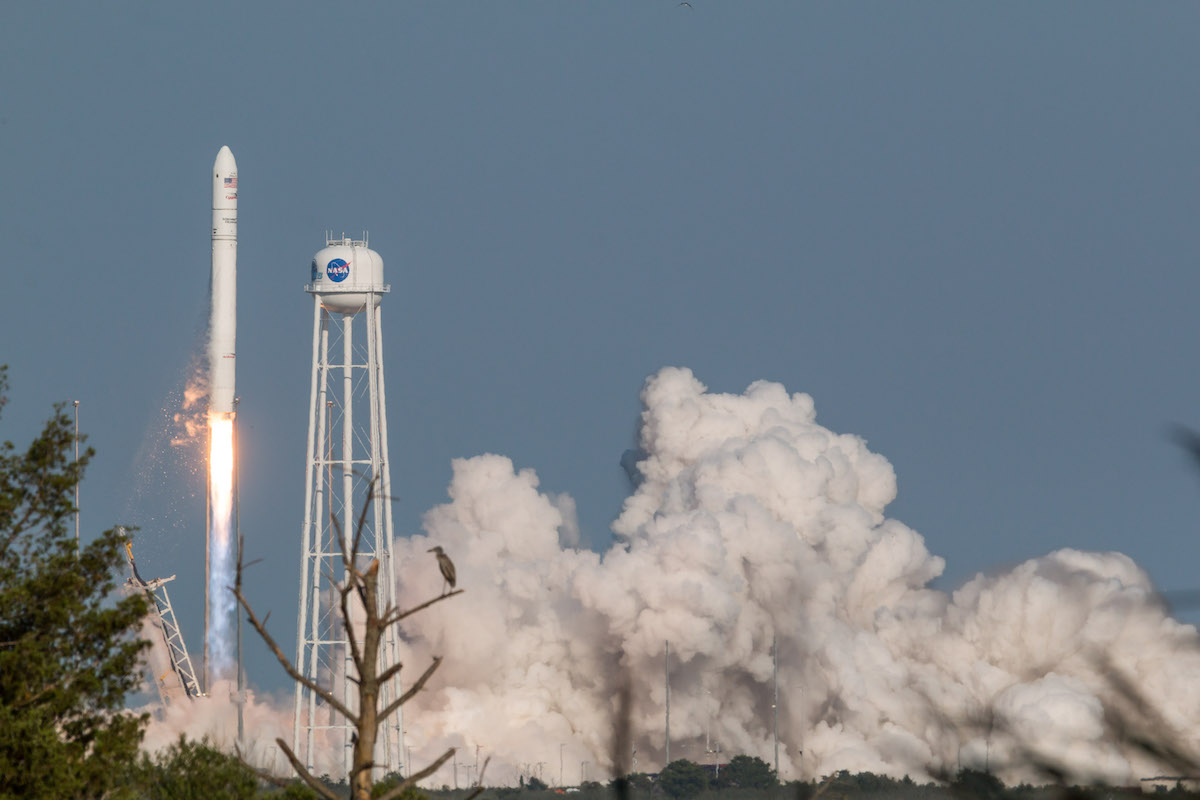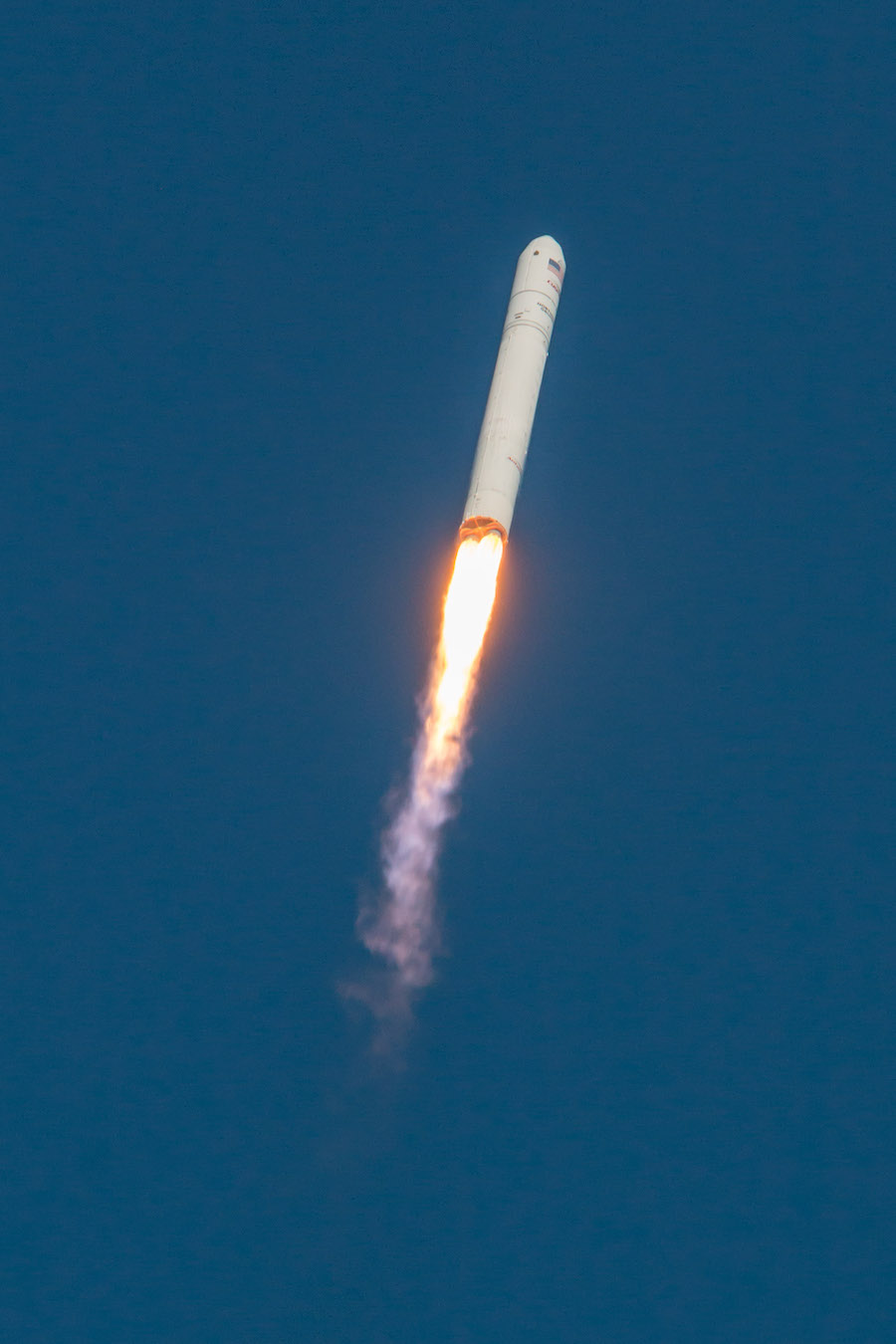
A successful launch from Virginia aboard an Antares rocket Tuesday kicked off Northrop Grumman’s 16th commercial resupply flight to the International Space Station, setting the stage for arrival of more than 8,000 pounds of cargo at the complex Thursday.
The two-stage Antares launcher ignited its twin Russian-made RD-181 engines and took off from pad 0A at the Mid-Atlantic Regional Spaceport at 6:01:05 p.m. EDT (2201:05 GMT) to begin Northrop Grumman’s NG-16 cargo mission.
Riding some 864,000 pounds of thrust, the 139-foot-tall (42.5-meter) Antares rocket arced downrange southeast from the launch base at Wallops Island, Virginia, lining up with the space station’s orbital plane to begin a 36-hour pursuit of the research outpost.
The liftoff was delayed five minutes Tuesday to allow time for Northrop Grumman’s launch team to reset a leaky valve in a helium pressurization system.
The first stage’s RD-181 engines shut down nearly three-and-a-half minutes into the flight. Moments later, the booster separated to fall into the Atlantic Ocean.
The rocket then jettisoned its nose cone and interstage adapter, before igniting its Castor 30XL solid-fueled second stage for a 2-minute, 45-second burn. The second stage accelerated Northrop Grumman’s Cygnus cargo freighter into orbit before deploying the supply ship nearly nine minutes after liftoff, capping an apparently flawless launch.
The Cygnus supply ship unfurled its two fan-shaped solar arrays a few hours into the mission to start generating power to charge the spacecraft’s batteries.
A series of thruster firings will fine-tune the Cygnus spacecraft’s rendezvous with the space station, culminating in a final approach from below the complex. Astronaut Megan McArthur aboard the station will use the Canadian-built robotic arm to capture the commercial resupply vessel around 6:10 a.m. EDT (1010 GMT) Thursday.
The robot arm will install the Cygnus spacecraft on the nadir, or Earth-facing, berthing port on the space station’s Unity module. Astronauts plan to open hatches and start unpacking the ship’s pressurized compartment later Thursday.

NASA has multibillion-dollar contracts with Northrop Grumman, SpaceX, and Sierra Nevada Corp. to ferry cargo to and from the space station. Northrop Grumman’s two resupply contracts, valued at up to $6 billion, covers at least 19 operational cargo missions through 2023.
The cargo launched aboard the Cygnus spacecraft included a technology demonstration to look at how future space explorers could 3D-print materials out of lunar soil.
The 3D printing demonstration, developed by Redwire, will use a “lunar regolith simulant” with physical properties and chemical composition similar to that of the moon’s soil, said Howie Schulman, the project lead for the Redwire Regolith Print mission.
The simulant is a fine gray powder, which will be combined with a thermoplastic binder to create the feedstock for the 3D printing experiment.
The experiment, developed in partnership with NASA’s Marshall Space Flight Center, will use Redwire’s commercially-operated Additive Manufacturing Facility on the space station. Redwire says it’s the first time that material designed to mimic lunar soil has been used for the 3D printing in space.
Hardware launched on the NG-16 mission for the 3D printing demonstration includes three custom-designed printing heads and three print bed surfaces, according to Redwire.
The material samples printed during the tech demo will be returned to Earth for analysis.
NASA and commercial companies are interested in 3D printing technology that could help manufacture components and infrastructure on the surface of the moon. Future lunar explorers could manufacture their own hardware instead of bringing materials from Earth, or relying on costly cargo shipments.
The NG-16 mission will also deliver spare parts for the space station’s toilet, a stowage rack for the lab’s airlock, and cooling fans for the station’s life support system.
The Cygnus spacecraft is also set to deliver a “mod kit” to configure the space station’s solar power truss for the arrival of the next pair of new roll-out solar arrays in late 2022. The first two new solar arrays were delivered to the station in June by a SpaceX Dragon cargo capsule, beginning an upgrade that will expand the lab’s power generation capability for another decade of operations.
Astronauts will install the “mod kit” on the station’s huge power truss during a spacewalk ahead of the arrival of the next two roll-out solar arrays.
Other payloads launched Tuesday included a biomedical research investigation looking at muscle loss in microgravity, and an experiment to test a more efficient thermal control system that could be used to dissipate heat on future spacecraft.
Here is a breakdown of the cargo on the NG-16 mission:
- Crew Supplies: 3,078 pounds (1,396 kilograms)
- Science Investigations: 2,346 pounds (1,064 kilograms)
- Vehicle Hardware: 2,286 pounds (1,037 kilograms)
- Unpressurized Cargo: 106 pounds (48 kilograms)
- Spacewalk Equipment: 33 pounds (15 kilograms)
- Computer Resources: 98 pounds (44 kilograms)

The Cygnus spacecraft flying on the NG-16 mission is named the S.S. Ellison Onizuka, honoring the first Asian American to fly in space. Onizuka was a NASA astronaut and U.S. Air Force colonel who died on the space shuttle Challenger in 1986.
The Cygnus spacecraft is scheduled to remain berthed at the space station for about three months.
After departing the research complex in November, the Cygnus cargo craft will head for a destructive re-entry over the South Pacific Ocean, disposing of several tons of trash packed inside its pressurized compartment by space station astronauts.
One of the final experiments of the mission will be a test of heat shield technology using three small capsules stowed inside the Cygnus spacecraft.
When the Cygnus breaks apart during re-entry, the capsules will plunge deeper into the atmosphere protected by heat shields made of different types of materials.
Led by engineers at the University of Kentucky, the experiment will collect data from sensors embedded in each capsule’s heat shield. The measurements will be transmitted back to the science team via the Iridium satellite network.
The developers of the re-entry experiment say the data will help validate computer models used in spacecraft design.
Email the author.
Follow Stephen Clark on Twitter: @StephenClark1.
